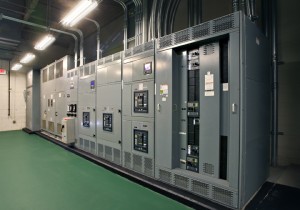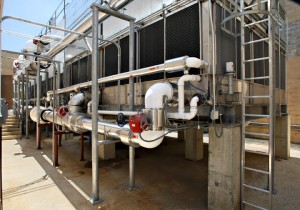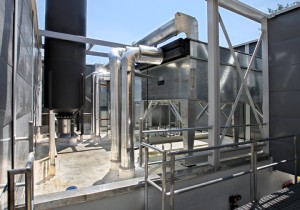U.S. hospitals spend nearly $5 billion annually on energy and related costs. Most main hospital buildings in the U.S. are more than 20 years old so it’s not too hard to realize that a significant portion of that spending could be curbed through improvements in energy use.1 By upgrading energy nationwide, about $100 million could be saved each year in power costs, according to the Department of Energy.

Energy dependent
The healthcare sector has grown more dependent upon electricity as digital medical records and equipment become increasingly essential to patient care. Energy consumption in healthcare facilities is the second largest expense behind staff compensation. This consumption and energy reliability is a top concern for healthcare facility management, especially since critical hospital energy systems must be online and available 24 hours a day, even when the power grid is compromised.
By reducing dependence on the electrical grid or oil, a hospital lessens its exposure to volatile energy commodity prices. Additionally, when a hospital is able to remain functioning during an emergency such as Hurricane Sandy or winter storms that knock out power for days, the hospital becomes an even more vital community resource to the citizens it serves.2
Unfortunately, a 2011 hospital energy management survey showed that the majority of hospitals have not yet undertaken key steps necessary to achieve grid independence. These steps include conducting regular energy audits, developing a strategic master energy plan, monitoring baseline energy performance and implementing on-site power systems.
Facility challenges
Upgrading aging facility infrastructures and equipment that inefficiently consume energy are historically not prioritized because of competing clinical needs and limited capital dollars. This lack of access to sufficient capital restricts the ability of these institutions to achieve efficient operations.
Both public and private hospitals have worked hard to control their operating costs in the face of thinning margins, an uncertain economy and a challenging regulatory environment. As a result, many have deferred or are deferring facilities’ maintenance projects based on budget constraints and the need to place quality patient care ahead of infrastructure improvements.3
Moving away from electricity grid dependency
Recent electrical grid failures related to storms, overloads and security breaches have brought renewed attention to electricity system reliability, particularly for critical safety and medical infrastructure. According to a Pew Charitable Trust research report, “Combined Heat and Power Provides Energy Resiliency to Medical Facilities,” facilities equipped with combined heat and power systems have an established record of providing reliable off-grid power during major disruptions and are important components of hospitals’ resiliency plans that also lower utility costs.4 CHP systems are also superior to installing additional diesel generators (beyond those required to serve life safety and critical care loads), as these systems are not able to provide energy cost savings, they don’t create greater efficiency or savings and are dependent on the availability of diesel fuel. During prolonged outages such as what occurred with Hurricane Sandy, diesel supplies were depleted while natural gas supplies still flowed.

CHP technologies offer a dependable source of power and increase a facility’s resiliency by boosting off-grid operation capabilities, ensuring that hospital services are uninterrupted. These highly efficient systems also allow hospitals to run at greater capacity during grid failures when they might otherwise be reliant on emergency generators generally designed to serve solely life safety and critical care loads.5
Because of the ability of CHP to help save lives, reduce costs and pollution, withstand extreme weather and operate during blackouts, the Pew Charitable Trust recommends that its adoption should be encouraged at all medical facilities and other buildings that provide critical services to communities.
Fortunately, creative funding solutions, federal tax programs and many state and local incentives are available to help healthcare organizations improve their aging energy infrastructure and develop an energy system not dependent on the electric grid or back-up generators.
Infrastructure funding opportunity
While healthcare facilities face financial barriers to investing in these systems, forward-thinking institutions are taking advantage of Power Purchase Agreements to fund infrastructure improvements with little-to-no upfront costs. A PPA also allows the institution to purchase electricity and/or thermal power from the PPA provider; through these payments, the hospital is also paying off a portion of the cost of a new system. In this situation, the PPA provider is the equity investor/owner of the system and, as a for-profit entity, is able to bring federal and state tax benefits into the project economics. The PPA provider also helps the hospital reduce its project risk as it provides performance guarantees to the hospital and becomes the primary source of power for that institution, with excess power needs delivered by the grid or other systems.
PPAs help institutions mitigate costs, fund clean and renewable energy development, lower overall utility costs and access tax incentive programs that would be otherwise unavailable to a not-for-profit healthcare institution. This funding option leverages the benefits of on-site energy generation through third-party ownership.

Incentives
There are a range of generous incentives available to healthcare facilities interested in installing CHP technologies. Given these available incentives, and an interest by hospitals in both improving their environmental footprint and increasing facility resilience, CHP is becoming an attractive option for healthcare facilities of all types and sizes.
The DOE is playing a significant role in the effort to reduce costs and increase the use of renewable energy technologies. Likewise, the federal investment tax credit for industrial energy-efficiency projects can lower investment paybacks. The Environmental Protection Agency also has an online CHP policies and incentives database that allows users to search for CHP policies and incentives by state or at the federal level. This database has two primary purposes:
- Policymakers and policy advocates can find useful information on significant state/federal policies and financial incentives affecting CHP.
- CHP project developers and others can easily find information about financial incentives and state/federal policies that influence project development.
By being proactive about energy independence and taking the initiative to upgrade their facility infrastructure, facilities management and hospital administration can improve the overall footprint of healthcare. The use of PPAs to fund these projects, like CHP systems, makes this a win for healthcare organizations, the environment and the communities and patients they serve.
1 http://facilitymanagement.com/articles/green-2012-10-04.html (accessed January 29, 2015).
2 Ibid.
3 JPMorgan “Energy Performance Contract Financing as a Strategy: Transforming Healthcare Facilities Maintenance.”
4 Pew Charitable Trust, “Combined Heat and Power Provides Energy Resiliency to Medical Facilities,” August 27, 2014.
5 Boston Green Ribbon Commission and Health Care Without Harm, Powering the Future of Health Care: Financial and Operational Resilience: A Combined
Heat and Power Guide for Massachusetts Hospital Decision Makers, 2013.
6 Ibid.
Photos courtesy of Clark Construction Group, LLC.




